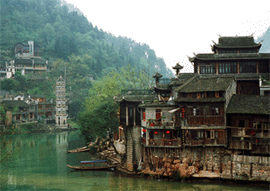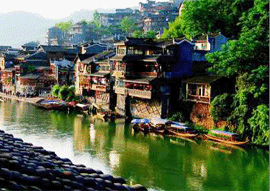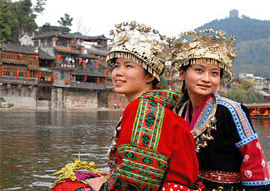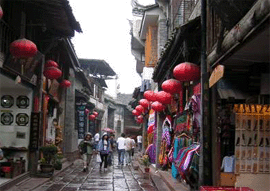Location & History: Fenghuang (Phoenix), an ancient town of historical and cultural significance, is small yet picturesque. Fenghuang is resided by many ethnics such as Miao, Tujia, Han, Hui people etc. The town was moved to its present site during about 1368-1644, when the major inhabitants were  soldiers, sent to quell Miao ethnic minority "riots" by the Ming Dynasty government. soldiers, sent to quell Miao ethnic minority "riots" by the Ming Dynasty government.
Built in 686 B.C., the ancient town was formerly named Weiyang and was located in today's Huangsiqiao town, about 24 kilometers from present-day Fenghuang. The city moved to its present site around 700 years ago, and the majority of its inhabitants were soldiers, sent to quell Miao ethnic minority "riots" by the Ming Dynasty government. All the wooden buildings in the town were built by Miao and Han people in Qing Dynasty (1644-1911), the ancient architectures have been kept intact, including the primitively simple and tranquil slabstone or flagstone paved streets and the stilted houses with strong local flavors on the river banks.
'Feng Huang' is Chinese for 'Phoenix', the mythical bird of good omen and longevity that is consumed by fire to be re-born again from the flames. Feng Huang Cheng or Phoenix Town is so called as legend has it that two of these fabulous birds flew over it and found the town so beautiful that they hovered there, reluctant to leave.
The town is situated on the western boundary of Hunan province in an area of outstanding natural  beauty where mountains, water and blue skies prevail. Upon entering the town the visitor will be impressed by its air of mystery, elegance and primitive simplicity. This is a world that is dominated by the color green. The mountain slopes are covered with green foliage, the fields are green and even the TuoJiang River reflects the greenery. The bridges over the water and unique houses built on stilts display a harmony that is so often portrayed in traditional Chinese paintings. This is particularly true when mist pervades the scene in the early morning or after rain. It soon becomes apparent that the claim to being one of the two most beautiful towns in the whole of China is more than justified together with the other town is Chang Ting in Fujian province. beauty where mountains, water and blue skies prevail. Upon entering the town the visitor will be impressed by its air of mystery, elegance and primitive simplicity. This is a world that is dominated by the color green. The mountain slopes are covered with green foliage, the fields are green and even the TuoJiang River reflects the greenery. The bridges over the water and unique houses built on stilts display a harmony that is so often portrayed in traditional Chinese paintings. This is particularly true when mist pervades the scene in the early morning or after rain. It soon becomes apparent that the claim to being one of the two most beautiful towns in the whole of China is more than justified together with the other town is Chang Ting in Fujian province.
Fenghuang Ancient Town is a wonderful example of what villages were like prior to the onset of modernization. Here dozens of alleys paved with flagstones run between the houses, each showing wear caused by the feet of generations of local people who have used them when going about their daily business. For the visitor, these alleys are the way to see the typical high gabled wooden houses built on stilts along the banks of the TuoJiang River at close quarters.
Customs & Culture: The Miao ethnic minority is predominantly settled here and a visit to a Miao village is a must when going to Feng Huang Cheng. The Miao women have a natural beauty that renders the use of cosmetics quite unnecessary. They love to dress in traditional blue garments set off with a white scarf. They love also their silver jewellery especially during festivals. Visitors will find a large array of hand made items of silver ornaments for sale in the local shops. Home made tie-dyes, printed and batik cloths are other local specialties that make wonderful souvenirs. The Miao are friendly and hospitable and like nothing more than to interact with visitors with a variety of traditional entertainments and activities. Food here also is different from that found elsewhere in China. Pickled red peppers are a particular local delicacy and their appetizing smell wafts from the many small family run restaurants.
Fenghuang town is most famous for its Miao-style tilted houses. These are two-story wooden structures whose lower stories are supported by several heavy logs standing tilted on the ground, and whose large, wide upper stories lean over the river. The upper story is beautifully crafted and decorated, with up-turned eaves and carved windows, doors and railings. The lower story has no living rooms, but the tilted sections are ornately carved. There are now only one dozen Qing Dynasty and early Republican period tilted houses extant. These are in Huilongtan, and many are rented out as holiday accommodation at a monthly rental of less than 200 Yuan. Overnight visitors pay only 20 Yuan, but buying such a house would cost over 500,000 Yuan.
Famous People Here: Fenghuang town was home to the versatile writer Shen Congwen (1902-88) who contributed greatly to the development of modern Chinese literature. Venerated by the local residents, the one time home and the tomb of this famous writer have become tourist attractions. Shen Congwen (1902-1988), originally named Shen Yuehuan, was born and bred in TuojiangTown, Fenghuang County in Hunan Province. He was a great modern Chinese writer as well as a research scholar of historical cultural relics. More than seventy kinds of various works, with a total of more than five million characters were published in his lifetime. His magnum opus includes Bian Cheng (Frontier City), Chang He (Long River) and Congwen Zizhuan (The Autobiography). He was one of most  representative writers of Chinese modern novels both at home and abroad. representative writers of Chinese modern novels both at home and abroad.
Dragon Nest Gorge
Zuo long Gorge lies in Gu Zhang County in the western part of Hunan province. It is about 6.5 km long. Because of the erosion of water and wind, it has formed unique geographic structure after 3 million years. It is just like a hermit among the reclusive forest. It is famous for its steep cliffs, luxurious forest, ancient vines, and rough trails. The sceneries are thrilling, amazing, and breath-taking. It winds its way like a dragon, so it is named Zuo long Gorge. When you travel in the valley, you not only need strong body, but also perseverance. You just challenge yourself, when you make it, you just conquer the nature and you will be proud of yourself. There are several waterfalls and small ponds. If you want, you could swim in ponds, get close to nature and will be far away form hustle and bustle.
Ma Wang Dui Han dynasty tombs
It is like a window through which we can see the civilization of more than 2000 years ago in Han dynasty. It is like an encyclopedia including many aspects such as, politics, economy, and culture. Some techniques are amazing even today; its advanced textile technique is unparalleled and a lot of patterns so complicated. Today we can’t duplicate. The female's corps is a wet body. It is definitely different form the dried mummies in Egypt. That proves our medicine has reached a high level. Unearthed items include lacquer works, silk manuscripts .A lot of things are helpful to research military, medicine, astronomy and so on. It is the treasure of our country. The whole world was shocked when the news was. |
